 |
A Short Tour of the Church - Part Two
|
|
|
|
The Windows of the North Wall
On the north wall of the Chancel two early fourteenth century windows have identical tracery in two and one-light versions. The window by the pulpit was blocked up for many years - its flatter arch shows it to be late perpendicular. The thirteenth century arcade has been rebuilt to parallel the fifteenth century south wall of the chapel and not the twelfth century chancel wall, so the east window is no longer centrally placed. As a sixteenth century source mentions a wall on the Chancels south side, the arcade may have been imported in the seventeenth century. |
|
 Back to Top Back to Top |
|
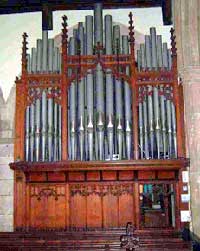 |
The OrganThe organ is a Father Willis of 1896 which replaced one installed in the nave by the Rev. Thomas Crick. |
 Back to Top Back to Top |
|
The Anchorite’s Cell
The Anchorite's Cell communicated with the church through the round opening in the north wall. The door of the cell was blocked up so that he or she depended for every necessity on the alms left on the ledge in the church. The floor of the cell was excavated in 1936 and can be seen outside. |
|
 Back to Top Back to Top |
|
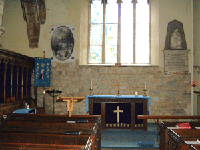 |
The ChapelThe Chapel was built in the fifteenth century and was once known as the Spilsill Chapel; belonging to the family of that name. It may also be the Chancel of the Blessed Virgin Mary alluded to in the will of Elisa Somery (the family from Ely Court) who died in 1464, directing that she should be buried near the bones of her husband Robert. The private door has its own holy water stoup. The altar tomb in Bethersden marble is that of 'Walter Mayney of Spilsill and was originally placed where the altar now is. Walter and his two wives were portrayed in brass on top of the tomb - unfortunately only one brass now remains. |
| After the First World War the chapel was redecorated and renamed St. George's Chapel and became the village War Memorial. In 1966 the stonework was uncovered and the chapel beautified. |
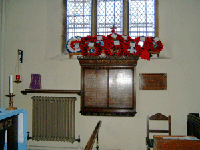 |
 Back to Top Back to Top |
|
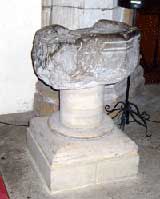 |
FontsTwo Fonts can be seen; the original, battered by time was placed below the pulpit after being rediscovered as a feeding trough on a local farm. (Arthur Mee has a touching story of it being identified by a blind woman). It is carved from a single block of very hard Kentish ragstone, unlike any other used in the church. It may originally have been placed in a recess as the back is not carefully shaped and the carving stops at the half-way line. |
| It was replaced by a new font in 1815 which stood by the south door. During the re-ordering of 1995, this new font was moved to the west porch and the original placed in its present position by the wide pier between the chancel and the chapel. |
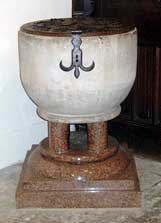 |
 Back to Top Back to Top |
|
Registers
The Registers are complete back to 1538 Queen Elizabeth I proclaimed in 1597 that all registers should be copied on to parchment and the paper ones returned to the Crown upon pain of general beheading: ours is one of seven Kentish Registers still extant on paper. It contains prayers for departed souls which were left out of the 1597 copy as well as neighbourly gossip such as: “1549. The xixte day of November. There was buried Agnes, a poor woman and a stranger, whose husbande brake his neck in London, as she reported”.
There are instances of the Christian name “Creature” given to children not expected to live and therefore baptised by the midwife: “1547. The xxviith of Apryle. There were borne ii children of Alexander Beerye the one christened at home and so deceased, called Creature the other christened at churche called Johan”. (At least two Creatures grew up to be married).
In Queen Mary's reign, between June 1556 and March 1558/9 the godparents' names are given, as ordered by Cardinal Pole. This ceases early in Queen Elizabeth's reign. Richard Besely, a chaplain to Henry VIII, and Rector from 1535 to 1554 and 1558 to 1585 (he was deprived of the living in Mary's reign because he was a married clerk) took great pleasure in recording his marriage in the Register He espoused Jane Lenarde, in his own words, “orphan, spinster, dowerless, modest and honest”. The marriage took place in Lent, on March 27 1548 before the Bill legalising the Act of Convocation allowing clergymen to marry had been passed by Parliament. Besely also anticipated by celebrating Holy Communion in English, with guests, bride and groom partaking, one week before the Bishops authorised it. On the same day that the new Prayer Book in English was authorised to be used in churches, June 9 1549, he baptised his three day old daughter Marie: “the parsone christinied his owne childe”. To a congregation accustomed to a celibate priesthood, this was astounding.
To boost the failing cloth industry a law was passed staring that everyone should be buried in a woollen shroud, and relatives had to produce a certificate to prove it. The Register of Burials in Woollen, which runs from 1679 to 1744, contains lists of “poore persons” among whom the £5 fine for those rich enough to be buried in linen was shared, '50 shillings to the poore and 50 shillings pd to the informer'. On March 6 1690/1 the entry is, “Buried Mary ye wife of John Usborn, an affidavit of wch was brought in due time”, all as usual. But on the next page is “a true account of the monies distributed to the poor... on ye account of Mary Usborn's buriall in Linnen.... Martin Collier informer”. He is the only one named in all the 65 years the book covers.Staplehurst Parish Registers from Rootsweb.com
Church Tour Part One
|
 Back to Top Back to Top |
|
 Back to Top Back to Top
|
 |